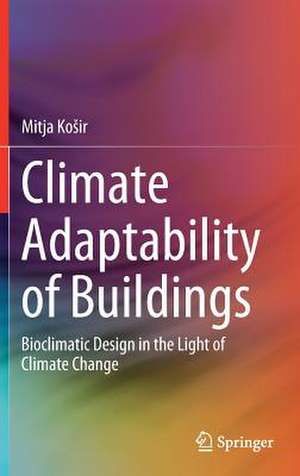Climate Adaptability of Buildings: Bioclimatic Design in the Light of Climate Change
Autor Mitja Koširen Limba Engleză Hardback – 8 mai 2019
- Why do we construct buildings and why do they matter?
- Where should we get started with bioclimatic design?
- The opportunities and potential held by climate for the by bioclimatic architecture and design.
- How and why should we design bioclimatic buildings to accommodate future climatic conditions?
- Climatic changes and implications for the bioclimatic design of buildings.
The book offers a valuable source of information for researchers and architectural engineers, who will gain essential insights into the process of using the available tools and data to design buildings that can respond to future climate challenges, as well as a general introduction into the field of bioclimatic building design. The book will also be of interest to graduate students and architects, as it approaches bioclimatic design with a particular focus on the analytical design process for such buildings.
Preț: 492.74 lei
Nou
Puncte Express: 739
Preț estimativ în valută:
94.32€ • 102.48$ • 79.28£
94.32€ • 102.48$ • 79.28£
Carte tipărită la comandă
Livrare economică 21 aprilie-05 mai
Preluare comenzi: 021 569.72.76
Specificații
ISBN-13: 9783030184551
ISBN-10: 3030184552
Pagini: 249
Ilustrații: XII, 243 p.
Dimensiuni: 155 x 235 mm
Greutate: 0.54 kg
Ediția:1st ed. 2019
Editura: Springer International Publishing
Colecția Springer
Locul publicării:Cham, Switzerland
ISBN-10: 3030184552
Pagini: 249
Ilustrații: XII, 243 p.
Dimensiuni: 155 x 235 mm
Greutate: 0.54 kg
Ediția:1st ed. 2019
Editura: Springer International Publishing
Colecția Springer
Locul publicării:Cham, Switzerland
Cuprins
1.Why Do Buildings Matter?.- 2.Bioclimatic Design – Where to Start?.- 3.Climate – Bioclimatic Opportunities and Possibilities.- 4.Bioclimatic Potential – A Way to Determine Climate Adaptability.- 5. Bioclimatic strategies – a way to attain climate adaptability.- 6. Climate change and its implications for bioclimatic design.
Notă biografică
Mitja Košir’s primary research interest is in the field of building energy performance and daylighting in connection with the design of high-performance buildings. In recent years his work has broadened to the field of bioclimatic climatological analysis with respect to the past, present and future energy performance of buildings. He has authored or co-authored numerous research papers, and has actively taught at the Faculty of Civil and Geodetic Engineering and Faculty of Health Sciences, University of Ljubljana, Slovenia, where he chiefly focuses on bioclimatic design, energy efficiency in buildings, daylighting and smart buildings. As part of his research and teaching activities, he has been involved in the development of several simple design tools for bioclimatic and energy performance analysis.
Textul de pe ultima copertă
This book examines bioclimatic design with a focus on the application of climate adaptability in the design of future buildings and renovation of existing energy-efficient buildings. It addresses the challenge of how to construct and renovate buildings so that they maintain desired performance even as the climate changes in future decades. The book is divided into six chapters that guide the reader from basic concepts to discussions on specific aspects of bioclimatic design, including:
The book offers a valuable source of information for researchers and architectural engineers, who will gain essential insights into the process of using the available tools and data to design buildings that can respond to future climate challenges, as well as a general introduction into the field of bioclimatic building design. The book will also be of interest to graduate students and architects, as it approaches bioclimatic design with a particular focus on the analytical design process for such buildings.
- Why do we construct buildings and why do they matter?
- Where should we get started with bioclimatic design?
- The opportunities and potential held by climate for the by bioclimatic architecture and design.
- How and why should we design bioclimatic buildings to accommodate future climatic conditions?
- Climatic changes and implications for the bioclimatic design of buildings.
The book offers a valuable source of information for researchers and architectural engineers, who will gain essential insights into the process of using the available tools and data to design buildings that can respond to future climate challenges, as well as a general introduction into the field of bioclimatic building design. The book will also be of interest to graduate students and architects, as it approaches bioclimatic design with a particular focus on the analytical design process for such buildings.
Caracteristici
Describes how to design buildings for the future climate Examines the theory and application of bioclimatic building design Provides practical examples from real-world building projects
